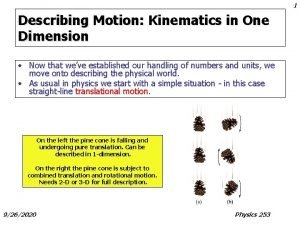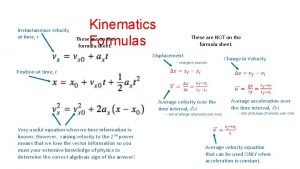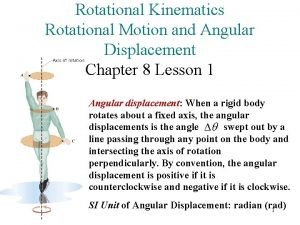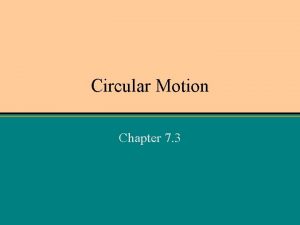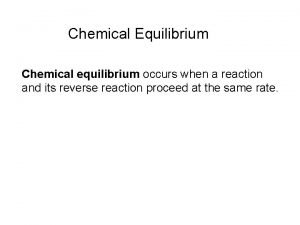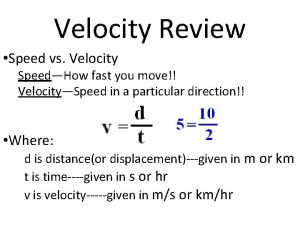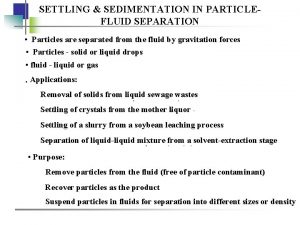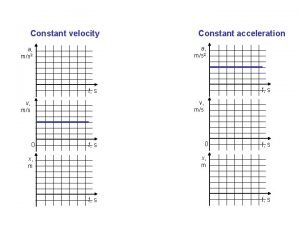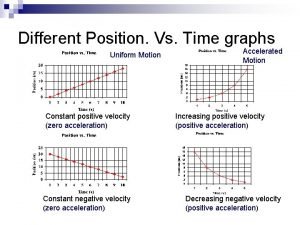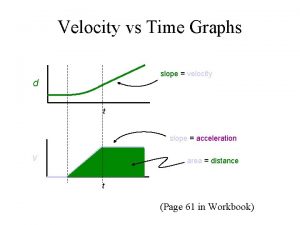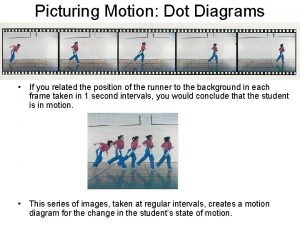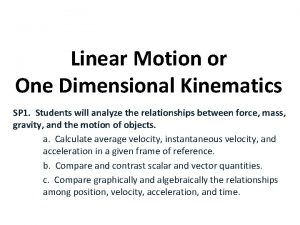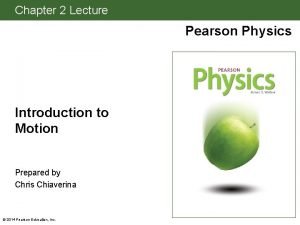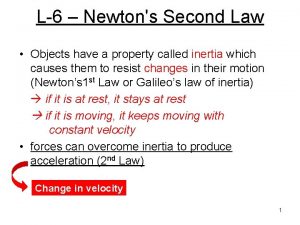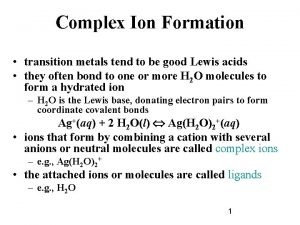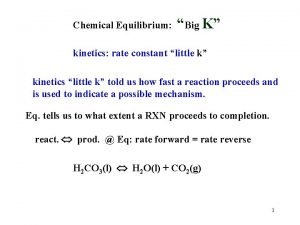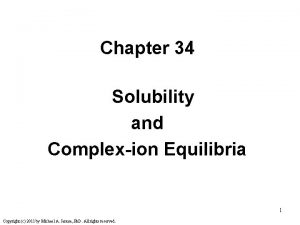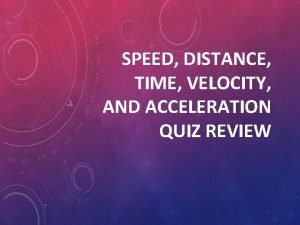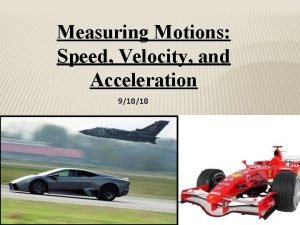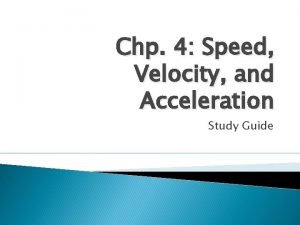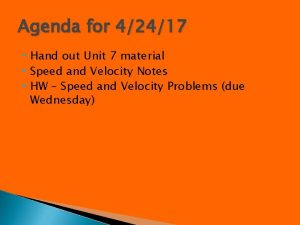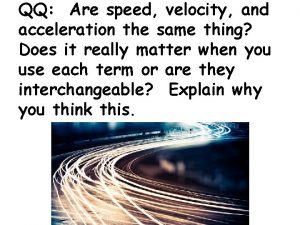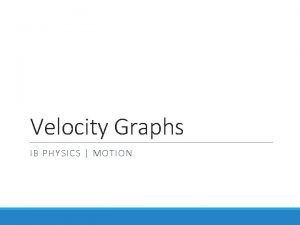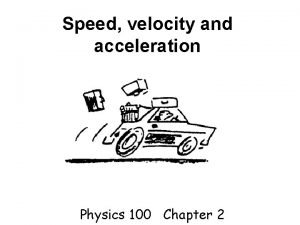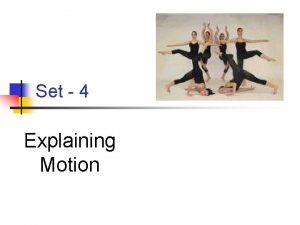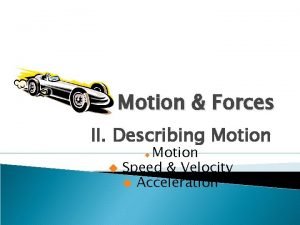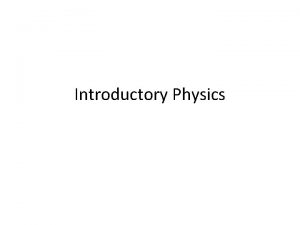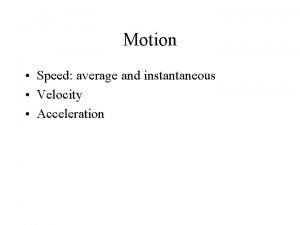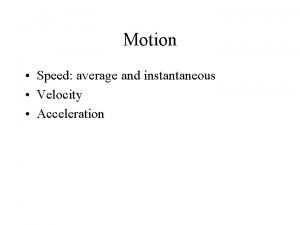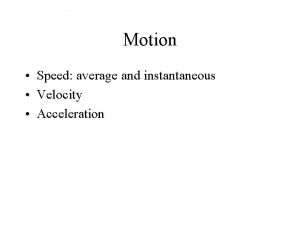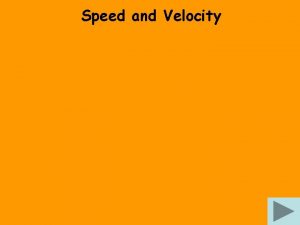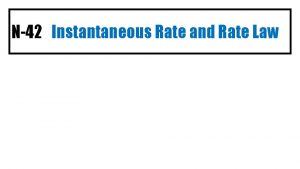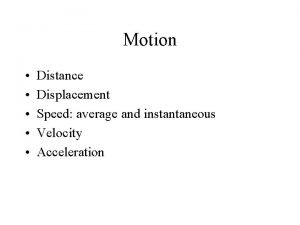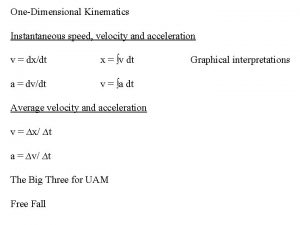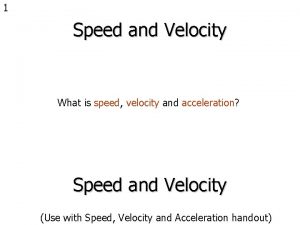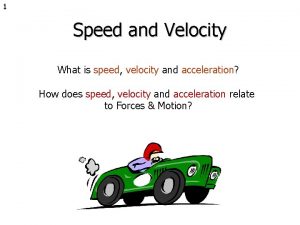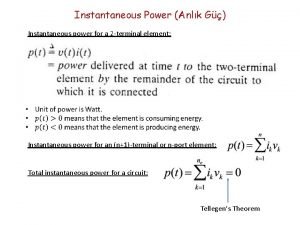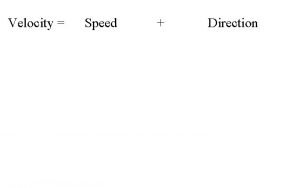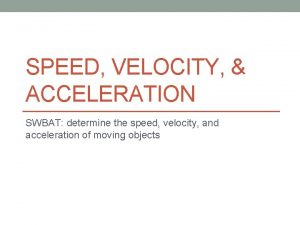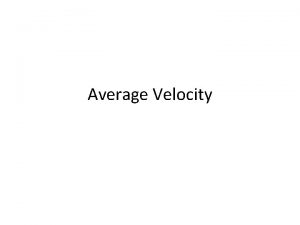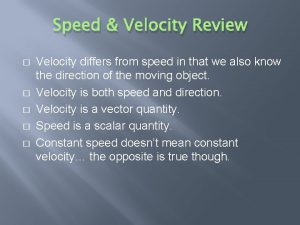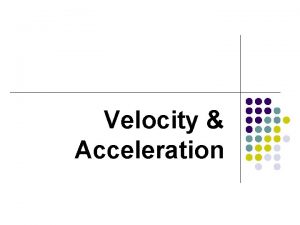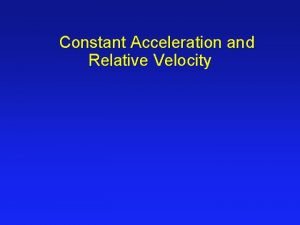Speed and Velocity speed constant speed instantaneous speed
























































- Slides: 56

Speed and Velocity • speed • constant speed • instantaneous speed • average speed • velocity

What is speed? Speed is a measure of the distance an object travels in a unit of time. What is speed?

What is speed? (cont. ) You can calculate speed by dividing the distance traveled by the time it takes to go that distance.

What is speed? (cont. ) Constant speed is the rate of change of position in which the same distance is traveled each second.

What is speed? (cont. ) When the car’s speed changes, it moves a different distance each period of time.

What is speed? (cont. ) • Instantaneous speed is speed at a specific instant in time. • Average speed is the total distance traveled divided by the total time taken to travel that distance.

Distance-Time Graphs • Graphs that show comparisons between distance and time are called distance-time graphs. • Constant speed is shown as a straight line on a distancetime graph.

Distance-Time Graphs (cont. ) • You can use distance-time graphs to compare the motion of two different objects. • The steeper line indicates a faster speed.

You can use distance-time graphs to calculate the average speed of an object.

Distance-Time Graphs (cont. ) How can you use a distancetime graph to calculate average speed?

Distance-Time Graphs (cont. ) If the speed of an object changes instead of being constant, its motion on a distance-time graph is a curved line.

Velocity is the speed and the direction of a moving object. velocity from Latin velocitas, means “swiftness, speed”

Velocity (cont. ) • The velocity of an object can be represented by an arrow. • A greater speed is shown by a longer arrow. • The arrow points in the direction of the object’s movement.

Velocity (cont. ) Velocity changes when the speed of an object changes, when the direction that the object moves changes, or when both the speed and the direction change.

Velocity (cont. ) How can velocity change?

• Speed is a measure of the distance an object travels in a unit of time. You can describe an object’s constant speed, instantaneous speed, or average speed. • A distance-time graph shows the speed of an object.

• Velocity includes both the speed and the direction of motion.

The total distance traveled divided by the total time taken to travel that distance is known as which of these? A. speed B. constant speed C. instantaneous speed D. average speed

Units of speed are units of distance divided by which of these? A. units of speed B. constant speed C. units of time D. average speed

How is constant speed represented on a distance-time graph? A. a wavy line B. a crooked line C. a straight line D. a curved line

Do you agree or disagree? 3. Constant speed is the same thing as average speed. 4. Velocity is another name for speed.

Acceleration • What are three ways an object can accelerate? • What does a speed-time graph indicate about an object’s motion?

Acceleration • acceleration

Acceleration—Changes in Velocity • Acceleration is a measure of how much the velocity of an object changes in a unit of time. • An object accelerates when its velocity changes as a result of increasing speed, decreasing speed, or a change in direction.

Acceleration—Changes in Velocity (cont. ) Acceleration has a direction and can be represented by an arrow.

Acceleration—Changes in Velocity (cont. ) What are three ways an object can accelerate?

Calculating Acceleration is a change in velocity during a time interval divided by the time interval during which the velocity changes.

Calculating Acceleration (cont. ) Acceleration is in the direction of motion if it is positive and opposite the direction of motion if it is negative.

Speed-Time Graphs • A speed-time graph shows how speed changes over time. • A speed-time graph has time on the horizontal axis—the x-axis, and speed on the vertical axis—the y axis.

Speed-Time Graphs (cont. ) horizontal from Greek horizein, means “limit, divide, separate” vertical from Latin verticalis, means “overhead”

Speed-Time Graphs (cont. ) An object at rest is not moving, so its speed is always zero.

Speed-Time Graphs (cont. ) For an object moving at constant speed, the speed-time graph is a horizontal line.

Speed-Time Graphs (cont. ) The line on the speed-time graph for an object that is speeding up has an upward slope.

Speed-Time Graphs (cont. ) The line on the speed-time graph for an object that is slowing down has a downward slope.

Speed-Time Graphs (cont. ) What does a speed-time graph show about the motion of an object?

Summarizing Motion • There are several ways to describe motion. • You can describe position by direction and distance from a reference point. • You can compare distance and displacement to find average speed. • You can describe velocity by speed and direction.

• An object accelerates if it speeds up, slows down, or changes direction.

• Acceleration in a straight line can be calculated by dividing the change in speed by the change in time.

• A speed-time graph shows how an object’s speed changes over time.

An objects accelerates when its velocity changes as a result of which of these? A. increasing speed B. decreasing speed C. a change in direction D. all of the above

On a speed-time graph, where is time located? A. the horizontal axis (the x-axis) B. the vertical axis (the y-axis) C. both of these D. neither of these

Which of these refers to a change in velocity during a time interval divided by the time interval during which the velocity changes? A. acceleration B. speed C. velocity D. none of these

Do you agree or disagree? 5. You can calculate acceleration by dividing the change in velocity by the change in distance. 6. An object accelerates when either its speed or its direction changes.

Key Concept Summary Interactive Concept Map Chapter Review Standardized Test Practice

The motion of an object can be described by the object’s position, velocity, and acceleration.

Lesson 1: Position and Motion • An object’s position is its distance in a certain direction from a reference point. • The position of an object in two dimensions can be described by choosing a reference point and two reference directions, and then stating the distance along each reference direction. • The distance an object moves is the actual length of its path. Its displacement is the difference its initial position and its final position.

Lesson 2: Speed and Velocity • Speed is the distance an object moves in a unit of time. • An object moving the same distance each second is moving at a constant speed. The speed of an object at a certain moment is its instantaneous speed. • You can calculate an object’s average speed from a distance-time graph by dividing the distance the object travels by the total time it takes to travel that distance. • Velocity changes when speed, direction, or both speed and direction change.

Lesson 3: Acceleration • Acceleration is a change in velocity over time. An object accelerates when it speeds up, slows down, or changes direction. • A speed-time graph shows the relationship between speed and time and can be used to determine information about the acceleration of an object.

Which of the below can be illustrated with a distance-time graph? A. comparisons between the motion of two objects B. the average speed of an object C. comparisons between distance and time D. all of the above

If acceleration is in the direction of motion, which of these is true? A. It is positive. B. It is negative. C. The object is at rest. D. The speed-time graph has a downward slope.

Where is speed located on a speed-time graph? A. the horizontal axis (the x-axis) B. the vertical axis (the y-axis) C. Speed is not indicated on a speed -time graph. D. The speed is the slope of the line.

When you describe an object’s position, the opposite direction is which of these? A. the positive direction B. the negative direction C. the reference direction D. none of these

Which term refers to the process of changing position? A. displacement B. reference point C. motion D. velocity

Which of these describes the speed and the direction of a moving object? A. velocity B. constant speed C. average speed D. instantaneous speed

Which of these results in a change of velocity? A. the speed of an object changes B. the direction an object moves changes C. both the speed and direction of an object changes D. all of the above

Which term refers to a measure of how much the velocity of an object changes in a unit of time? A. direction B. speed C. acceleration D. velocity
 Instantaneous velocity vs average velocity
Instantaneous velocity vs average velocity Instantaneous velocity
Instantaneous velocity Kinematics formulas sheet
Kinematics formulas sheet Find the instantaneous velocity
Find the instantaneous velocity Si unit for angular displacement
Si unit for angular displacement Instantaneous velocity circular motion
Instantaneous velocity circular motion Angular and linear quantities
Angular and linear quantities Initial velocity and final velocity formula
Initial velocity and final velocity formula Constant acceleration speed time graph
Constant acceleration speed time graph Constant pointer and pointer to constant
Constant pointer and pointer to constant Constant pointer and pointer to constant
Constant pointer and pointer to constant Constant pointer and pointer to constant
Constant pointer and pointer to constant Equilibrium of chemical reactions
Equilibrium of chemical reactions Constant pointer and pointer to constant
Constant pointer and pointer to constant Constant pointer and pointer to constant
Constant pointer and pointer to constant Filter press equation
Filter press equation Gas constant r
Gas constant r Limitations of darcy's law
Limitations of darcy's law Is v final velocity
Is v final velocity Darcy s law
Darcy s law Angular velocity to tangential velocity
Angular velocity to tangential velocity Angular acceleration formula in terms of radius
Angular acceleration formula in terms of radius Constant speed graph
Constant speed graph Fluidization velocity
Fluidization velocity Steady state error in control system
Steady state error in control system Velocity constant
Velocity constant Constant velocity buggy
Constant velocity buggy Uniform motion graphs
Uniform motion graphs Constant velocity model
Constant velocity model Velocity slowing down graph
Velocity slowing down graph Motion dot diagrams
Motion dot diagrams 1 dimensional kinematics
1 dimensional kinematics Constant velocity position time graph
Constant velocity position time graph Newton's second law constant velocity
Newton's second law constant velocity Formation constant vs equilibrium constant
Formation constant vs equilibrium constant Big k little k
Big k little k Complex ion formation and solubility
Complex ion formation and solubility Ksp values table pdf
Ksp values table pdf Acceleration quiz
Acceleration quiz Speed velocity and acceleration problems answers
Speed velocity and acceleration problems answers What is motion in a straight line
What is motion in a straight line Constant speed on distance time graph
Constant speed on distance time graph How is velocity different from speed
How is velocity different from speed Velocity describes both speed and
Velocity describes both speed and Speed, velocity and acceleration formula
Speed, velocity and acceleration formula Speed velocity and acceleration study guide answers
Speed velocity and acceleration study guide answers Speed challenge lab
Speed challenge lab Are speed and acceleration the same thing
Are speed and acceleration the same thing Youtube https //www.youtube.com/watch v=vnp84pn0mjq
Youtube https //www.youtube.com/watch v=vnp84pn0mjq The main difference between speed and velocity involves
The main difference between speed and velocity involves Speed, velocity and acceleration notes
Speed, velocity and acceleration notes Chapter 1 lesson 2 speed and velocity answer key
Chapter 1 lesson 2 speed and velocity answer key What is velocity
What is velocity Velocity and speed
Velocity and speed F= ma units
F= ma units Difference between speed and velocity
Difference between speed and velocity Motion describe
Motion describe
